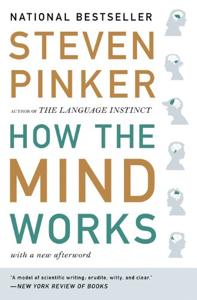
Want to learn the ideas in How The Mind Works better than ever? Read the world’s #1 book summary of How The Mind Works by Steven Pinker here.
Read a brief 1-Page Summary or watch video summaries curated by our expert team. Note: this book guide is not affiliated with or endorsed by the publisher or author, and we always encourage you to purchase and read the full book.
Video Summaries of How The Mind Works
We’ve scoured the Internet for the very best videos on How The Mind Works, from high-quality videos summaries to interviews or commentary by Steven Pinker.
1-Page Summary of How The Mind Works
Overall Summary
This book is about the mind and how it works. It explains that there are different theories to explain this, including a computational theory and a Darwinian evolutionary theory. The author uses these two theories to explain why the mind evolved and what its functions are today. This is not just an explanation of the mind; it’s also a criticism of other mindsets like Jerry Fodor’s “The Mind Doesn’t Work That Way”, which argues against Pinker’s ideas in this book.
Steven Pinker begins his book by discussing the basics of neurons and then moves on to more complex topics. He ends with sections that he feels are too difficult for his approach, such as free will. This structure mirrors one of the themes in his book: how we learn new things from what we already know and build upon it. In the first four chapters, he presents basic information about how brains work and how they’re structured. He discusses concepts like intelligence and consciousness. The focus is on computational theory of mind—how physical brain activity leads to human thought processes—and natural selection, which has shaped our current design for survival in a specific environment over thousands of years.
Chapter 4 examines more abstract processes, such as vision. Pinker argues that visual illusions are partially explained by evolution and that the mind forms ideas based on information it receives.
In the following chapters, Pinker examines how emotions, friendship and reasoning have evolved. He speculates on the purpose of each behavior in order to support his argument that harmony among people is a product of evolution. He also argues that male and female minds are similar in many ways. In chapter nine, he discusses art, music humor and philosophy as evolutionary goals.
Throughout this book, Pinker draws on two main theories to explain how the mind works. The physical structure of the brain is responsible for its computing abilities, while natural selection explains why humans developed complex minds in the first place. He focuses on flexibility and elegance in his explanation of these elements.
Chapter 1: “Standard Equipment”
Steven Pinker starts the book with a question: “Why are there so many robots in fiction, but none in real life?” He answers that question by saying that even simple actions like putting away a toy or walking require complex organization. That’s why we need to understand our minds and how they work.
The human body is amazing. We take for granted the things it does every day, such as seeing and hearing. The eyes process brightness in individual patches of our visual field as well as identify boundaries between objects and somehow create their three-dimensional relationships from two-dimensional impressions. Our brain then identifies those objects to make sense of what we see around us so quickly that we don’t even notice they’re happening.
Robots can be programmed to do simple tasks, such as processing the brightness of patches in a visual field. However, identifying objects is more difficult than it seems. Robots would need to have seen these objects before and have a large catalog of possible objects based on shape and size. They would also need to understand relations and context between those objects to pick out the one most likely being viewed at that time.
Philosophers and others have performed experiments to see how robots would handle various tasks. They’ve concluded that robots wouldn’t be able to do many things humans take for granted. Daniel Dennett argued that humans use a set of core rules when learning about the world, which is different from computers, who receive downloads of facts. It’s hard to determine what these rules are because they’re culturally relevant and nuanced instead of being straightforward like computer systems.






